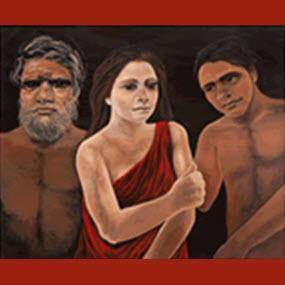Nestled in the heartland of Melbourne’s Jewish community in St Kilda, the Jewish Museum of Australia is a fascinating place. Its labyrinthine arrangement takes the viewer on an exciting trail, room upon room of artefacts and detailed explanation. Women in the Bible: Tricksters, Victors and (M)others is a new exhibition at the museum, and will run until March 2010. Simultaneously challenging and affirming womanhood and femininity, the exhibition explores the role women have played, from Eve to the modern woman, in shaping our world. Curated by Rebecca Forgasz, Women in the Bible brings together a wide variety of works (sourced from some of Victoria’s biggest institutions) to tell this story, from sources as varied as Dutch Renaissance engravers to present-day female Jewish artists. The fact that there is such a great variety of artists in this exhibition is not insignificant: it proves that the subject of this exhibition is both timeless, and has countless interpretations.
In her introduction to the exhibition, director of the Jewish Museum Helen Light suggested that the museum offers a safe place to explore unsafe ideas, and she was certainly accurate in applying that rule to this exhibition. Provocative questions are asked here, and perhaps the most challenging of these is the enquiry into whether the Bible is sexist. American artist Helene Aylon investigates this most directly in her work I Look Into The Passages (2005), with a series of passages the artist personally finds sexist literally placed under magnifying lenses for public scrutiny. When we consider that the Bible has been crucial in shaping views of women in Western civilisation for hundreds of years, questioning and reinterpreting representations of women in the Bible is not only interesting, it is necessary.
That being said, this exhibition offers more than critical analysis. It allows women, Jewish women in particular, to celebrate the great women of Biblical history – Eve, Rebekah, Esther, Sarah and Hagar, the Queen of Sheba – through a modern perspective. To allow for this, curator Rebecca Forgasz has gathered ten contemporary female artists who have contributed their work to this collection. Seeing a contemporary female approach to this subject matter is thrilling, and really the meaning in this exhibition relies on their input. Without these artists this exhibition might have been an historical look into the subordination of women in a patriarchal society. With them it is a reimagining of these women’s stories, a celebration of their lives, but most importantly, their womanhood. A fantastic example of this is Linde Ivimey’s Miriam (2009), a sculpture of the woman thought to be Moses’ older sister, constructed of laboriously sewn together chicken bones. The way she holds Moses in her hands is delicate, full of hope and life-giving.
This exhibition is special because it encourages women to recognise their stories as special, relevant, and an important part of history. It allows women to reengage with the Bible. Even the layout and signage around the space feels ‘feminine’ with its pink tones and hyperbolic Woman’s Day-style headings. Women in the Bible asks a lot of big questions, but they are questions that every woman (and man – they are welcome!) should think about, as their implications are still valid today.
Women in the Bible: Tricksters, Victors and (M)others
Jewish Museum of Australia
Loti Smorgon Gallery
15 October 2009 – 14 March 2010





